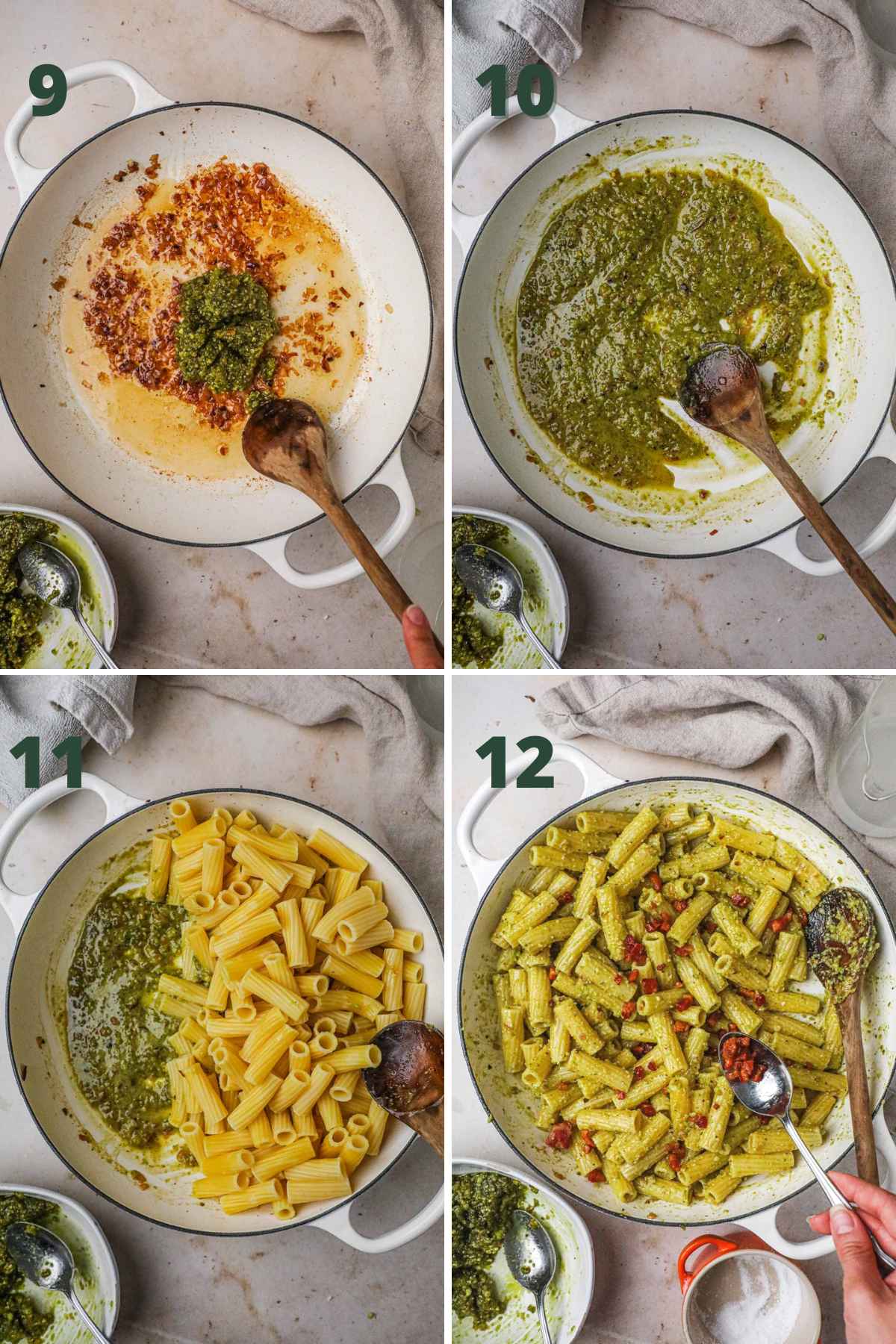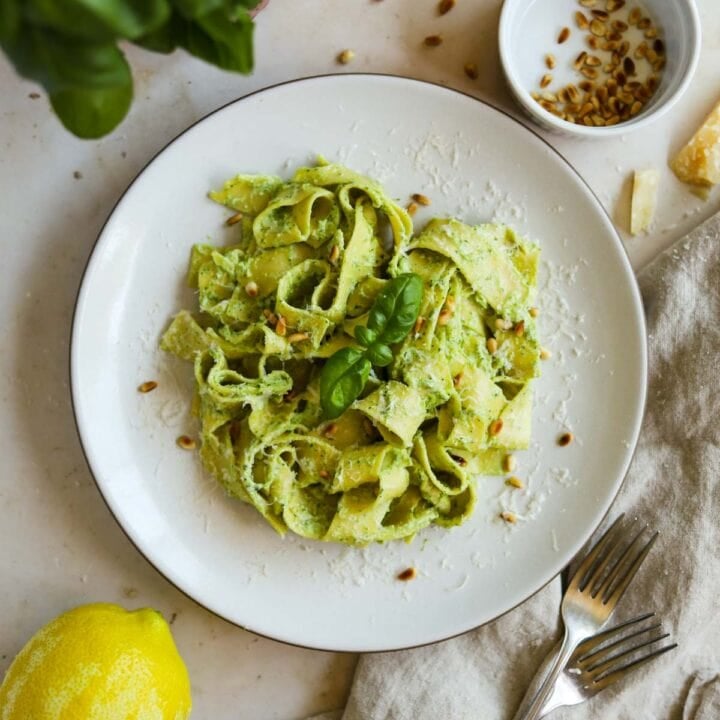Pistachio Pesto Pasta with Pancetta is a rich, creamy dish featuring al dente pasta tossed in a nutty pistachio pesto sauce and topped with crispy pancetta bits. Make in just 25 minutes for a date night at home or add it to your weeknight dinner rotation. Either way, we know you'll love it!

Pesto and pancetta make for a delicious flavor combination. The pesto is nutty and bright while the pancetta adds the perfect caramelized crunch. This dish is also surprisingly simple, it requires just a handful of ingredients and minimal effort.
Make this dish with a store-bought pistachio pesto or try it with our homemade pistachio pesto. This pasta will also be delicious with our classic basil pesto, spinach pesto, or red pepper pesto.
Jump to:
Why You'll Love This Pasta
- Taste - The pesto mixed with rigatoni and pancetta is satisfying and decadent.
- Texture - The sauce is light and the pancetta is perfectly crispy.
- Effort - This easy pasta recipe has just a couple steps. All you need to do is cook the pasta and pancetta, mix it in the pesto sauce, then enjoy!
- Time - It takes about 15 minutes to prep the ingredients then about 10 minutes to cook the pancetta and pasta.
Key Ingredients

- Pasta - We love a rigatoni or ridged penne (rigate) because the ridges soak up the pesto sauce well.
- Pancetta - Crispy pancetta are crispy and juicy bits of tastiness.
- Shallot - Shallots add a mild onion flavor.
- White wine - White wine deglazes the pan and adds a nice light flavor.
- Pistachio pesto - Pistachio pesto is uniquely nutty and delicious. Try our homemade pistachio pesto recipe for extra fresh pesto.
- Parmigiano-reggiano or pecorino romano - Sprinkle a little parm or pecorino for a nutty sharpness.
See recipe card for quantities.
Substitutions
- Onion - Use a small yellow onion or vidalia onion instead of a shallot. We don’t recommend using both onion and garlic as a substitute. As my Neapolitan Nonno says, “one smells and one stinks,” meaning, the two ingredients together will be too overpowering for the dish.
- Gnocchi - Use gnocchi instead of short pasta.
- Guanciale - Use guanciale instead of pancetta for a fragrant, herbaceous meat since guanciale is typically cured with rosemary.
- Crispy prosciutto - Try our easy crispy prosciutto instead of pancetta for a lighter but equally delicious and savory crunch.
- Non-alcoholic - In lieu of white wine, deglaze the pan with white wine vinegar, a mix of lemon juice and water, pasta water, or a splash of broth.
- Pesto - This pasta will also be delicious with a classic basil pesto. Our red pepper pesto, spinach pesto, and kale pesto are also great options with their own special flare.
Variations
- Vegetarian - Omit the pancetta and use olive oil instead of the rendered pancetta fat to make this dish vegetarian.
- Burrata - Add torn burrata to the final dish for a luxuriously cheesy spin.
- Heat - Add a small amount of crushed red pepper when you add the pesto to imbue heat.
How to Make Pistachio Pasta

- Toast pistachios (optional for garnish) - Place raw pistachios in a large cold pan and cook until toasted. Then remove the pan from the heat to cool and remove the pistachios from the pan. Chop until finely chopped and crumbly. Set aside. (Photo 1 and 2)
- Cook pancetta - While the pasta cooks, prepare the pancetta and shallot. Add the pancetta to the pan and turn the heat on to medium. Cook until caramelized then remove the pancetta from the pan. (Photo 3 and 4)

- Cook shallots - Add the shallots to the pan and cook in the pancetta fat. Then deglaze the pan with a splash of white wine and use a wooden spoon to scrape some of the fond (the browned bits stuck to the bottom of the pan) to incorporate into the dish. (Photo 5, 6, and 7)
- Cook pasta - In a large pot, bring salted water to a rolling boil over medium-high heat. Then add pasta to the water and cook until al dente per the packaging instructions. Time the pasta and the sauce so they are ready around the same time. Reserve a cup of pasta water and drain the pasta. (Photo 8)

- Make pesto sauce - Add about a ¼ cup of pasta water and the pistachio pesto to the pan and stir until combined with the heat on low. (Photo 9 and 10)
- Combine ingredients - Add the pasta to the pan and gently toss until the pasta is coated in the pesto. If the pasta is dry, add a little more pasta water, about a quarter cup at a time, until the pasta sauce reaches a silky consistency. You don’t have to use all of the pasta water. Once the pasta is well-coated with pesto, salt to taste and fold in the pancetta. Then serve in bowls and top with toasted pistachios and grated Parmigiano-reggiano or pecorino romano. (Photo 11 and 12)
Pro tip - Don’t use any olive oil in this dish. Since the pancetta naturally produces oil to cook the shallot in, there is no need to add olive oil. The only exception is if you omit the pancetta and make the dish vegetarian, you can use olive oil to cook the shallot.
What to Serve with Pistachio Pasta
We typically enjoy this rich but light pasta on its own or with a baguette for dipping in the sauce. If you want an extra filling meal, try it with a tasty appetizer like our Burrata Caprese or Pear and Prosciutto Rocket Salad.
Recipe FAQs
No, the pesto will heat up when it is added to the pan with the pasta.
Yes! If you are making homemade pistachio pesto, you can make it up to 5 days ahead of time and store it in the refrigerator.
Short shapes like penne rigate (ridged penne pasta), orecchiette, farfalle, or fusilli trap hold the sauce well. You can also use longer shapes like spaghetti, but the sauce may fall off more and be messier.

Storage
Refrigerate leftover pistachio pesto pasta in an air-tight container for up to 5 days. In order to reheat it, simply place the desired amount of leftover pasta in a braiser or dutch oven. Reheat over low heat, stirring occasionally until hot. You can also microwave the leftovers until warm.
Cooking Tips
- Salt the pasta water - Be sure to salt the pasta water so the pasta is extra flavorful.
- Lightly salt this dish to taste. Since there is salty cheese in the pistachio pesto, the pancetta is naturally salty, and the pasta water is salted, you don’t need to heavily salt this dish. Just add a little salt to taste if desired.
- Serve with bread - Enjoy this creamy pistachio pasta with a delicious roll or baguette to dip in the pesto sauce. In Italian, this is called "fare la scarpetta," or "make the little shoe."
- Remix the pesto - If you store and refrigerate any leftover pesto separately, be sure to mix it again before using it. The ingredients can separate overnight in the refrigerator.
Related Recipes
Did You Like This Recipe?
Love this easy pistachio pasta recipe? Please leave a 5-star rating in the recipe card below & consider leaving a comment below. If you are looking for another uniquely rich pasta, try our French Onion Soup Pasta.
Sign up for THP's newsletter and keep in touch on Instagram, Facebook, Pinterest, TikTok, and YouTube. If you make this recipe, tag #theheirloompantry so we can see your homemade pistachio pasta!
📖 Recipe
Pistachio Pesto Pasta
Equipment
Ingredients
- ¼ cup raw pistachios optional for garnish
- 1 lb short pasta
- 4 oz pancetta
- 1 shallot chopped
- ¼ cup white wine
- kosher salt
- 1 cup pistachio pesto
- Grated Parmigiano-reggiano or pecorino romano for serving
Instructions
- Toast pistachios (optional for garnish) - Place raw pistachios in a large cold pan and cook until toasted. Remove the pan from the heat to cool and remove the pistachios from the pan. Chop until finely chopped and crumbly. Set aside.¼ cup raw pistachios
- Cook pancetta and shallots - Add the pancetta to the same pan and turn the heat on to medium. Cook until caramelized then remove the pancetta from the pan. Add the shallots to the pan and cook in the pancetta fat. Deglaze the pan with a splash of white wine and use a wooden spoon to scrape some of the fond (the browned bits stuck to the bottom of the pan) to incorporate into the dish.4 oz pancetta, 1 shallot, ¼ cup white wine
- Cook pasta - While the pancetta and shallots cook, prepare the pasta. In a large pot, bring salted water to a rolling boil over medium-high heat. Then add pasta to the water and cook until al dente per the packaging instructions. Time the pasta and the sauce so they are ready around the same time. Reserve a cup of pasta water and drain the pasta.1 lb short pasta, kosher salt
- Combine ingredients - Add about a ¼ cup of pasta water and the pistachio pesto to the pan and stir until combined with the heat on low. Add the pasta to the pan and gently toss until the pasta is coated in the pesto. If the pasta is dry, add a little more pasta water, about a quarter cup at a time, until the pasta sauce reaches a silky consistency. You don’t have to use all of the pasta water. Once the pasta is well-coated with pesto, salt to taste and fold in the pancetta. Serve in bowls and top with the toasted pistachios and grated parmigiano-reggiano or pecorino romano.1 cup pistachio pesto, Grated Parmigiano-reggiano or pecorino romano
Video
Notes
- Refrigerate leftover pistachio pesto pasta in an air-tight container for up to 5 days. In order to reheat, heat over low heat in a braiser or dutch oven, stirring occasionally until hot. You can also microwave until warm.
- Don’t use olive oil in this dish. Since the pancetta naturally has oil to cook the shallot in, you don't need to add olive oil. The only exception is if you omit the pancetta, then you can use olive oil to cook the shallot.
- Be sure to salt the pasta water so the pasta is extra flavorful.
- Lightly salt this dish to taste. Since there is salty cheese in the pistachio pesto, the pancetta is naturally salty, and the pasta water is salted, you don’t need to heavily salt this dish. Just add a little salt to taste if desired.
- Enjoy with bread. Serve this creamy pasta with a delicious roll or baguette to dip in the pesto sauce. In Italian, this is called "fare la scarpetta," or "make the little shoe."
- Remix the pesto. If you store and refrigerate any leftover pesto separately, be sure to mix it again before using it. The ingredients can separate overnight in the refrigerator.












Leave a Reply